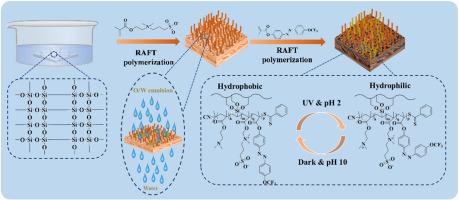RAFT聚合制备的油水按需分离可逆双刺激响应智能膜
IF 9
1区 工程技术
Q1 ENGINEERING, CHEMICAL
引用次数: 0
摘要
由于污染引起的通量下降,传统分离膜的性能下降。为了克服这一限制,本研究旨在开发一种精密表面工程策略,用于制造具有动态可调润湿性的防污膜,实现按需油水分离。以聚偏氟乙烯(PVDF)和聚(2-(二甲氨基)甲基丙烯酸乙酯-b-乙烯基三甲氧基硅烷)(P(DMAEMA-b-VTES))为核心材料,采用非溶剂诱导相分离(NIPS)技术制备基底膜(PVDF/PDV)。VTES片段通过水解-缩合实现了可逆加成-破碎链转移(RAFT)剂的共价固定化,促进了随后的表面功能化。具体来说,聚甲基丙烯酸亚砜甜菜碱(PSBMA)被接枝以构建超亲水性表面。psbma接枝膜具有良好的分离性能,分离通量达到334.6 ~ 1155.9 L m−2 h−1,效率稳定在91.5% ~ 97.3%。利用RAFT聚合的“活体”特性,进一步引入光响应单体三氟甲基偶氮苯甲基丙烯酸酯(F3CO-AZO-MA)构建动态润湿性控制层,得到PVDF/PDVSM-4智能响应膜。通过pH和紫外线的双重调节,膜可以灵活地在亲水性/疏水性和亲脂性/疏油性之间切换。这种双响应行为促进了表面活性剂稳定水乳状液和水乳状液的高效分离,为复杂油水体系的按需分离和膜再生提供了新的思路。本文章由计算机程序翻译,如有差异,请以英文原文为准。

Reversible dual-stimuli responsive intelligent membrane prepared by RAFT polymerization for on-demand oil-water separation
Conventional separation membranes suffer from performance degradation owing to fouling-induced flux decline. To overcome this limitation, this study aims to develop a precision surface engineering strategy for fabricating antifouling membranes with dynamically tunable wettability, enabling on-demand oil-water separation. Initially, polyvinylidene fluoride (PVDF) and poly(2-(dimethylamino) ethyl methacrylate-b-vinyltrimethoxysilane) (P(DMAEMA-b-VTES)) were used as core materials to prepare basement membranes (PVDF/PDV) by non-solvent induced phase separation (NIPS) technology. The VTES segment enabled covalent immobilization of a reversible addition-fragmentation chain-transfer (RAFT) agent through hydrolysis-condensation, facilitating subsequent surface functionalization. Specifically, poly sulfobetaine methacrylate (PSBMA) was grafted to construct superhydrophilic surfaces. The PSBMA-grafted membrane exhibited excellent separation performance, with separation flux reaching 334.6–1155.9 L m−2 h−1 and efficiency stabilized at 91.5 %–97.3 %. Capitalizing on the “living” nature of RAFT polymerization, the photo-responsive monomer trifluoromethylazobenzene methacrylate (F3CO-AZO-MA) was further introduced to construct a dynamic wettability control layer, and the PVDF/PDVSM-4 intelligent response membrane was obtained. The membrane can flexibly switch between hydrophilic/hydrophobic and lipophilic/oleophobic properties through the dual regulation of pH and ultraviolet light. This dual-responsive behavior facilitated efficient separation of surfactant-stabilized W/O and O/W emulsions, providing a new idea for on-demand separation and membrane regeneration of complex oil-water systems.
求助全文
通过发布文献求助,成功后即可免费获取论文全文。
去求助
来源期刊

Journal of Membrane Science
工程技术-高分子科学
CiteScore
17.10
自引率
17.90%
发文量
1031
审稿时长
2.5 months
期刊介绍:
The Journal of Membrane Science is a publication that focuses on membrane systems and is aimed at academic and industrial chemists, chemical engineers, materials scientists, and membranologists. It publishes original research and reviews on various aspects of membrane transport, membrane formation/structure, fouling, module/process design, and processes/applications. The journal primarily focuses on the structure, function, and performance of non-biological membranes but also includes papers that relate to biological membranes. The Journal of Membrane Science publishes Full Text Papers, State-of-the-Art Reviews, Letters to the Editor, and Perspectives.
 求助内容:
求助内容: 应助结果提醒方式:
应助结果提醒方式:


